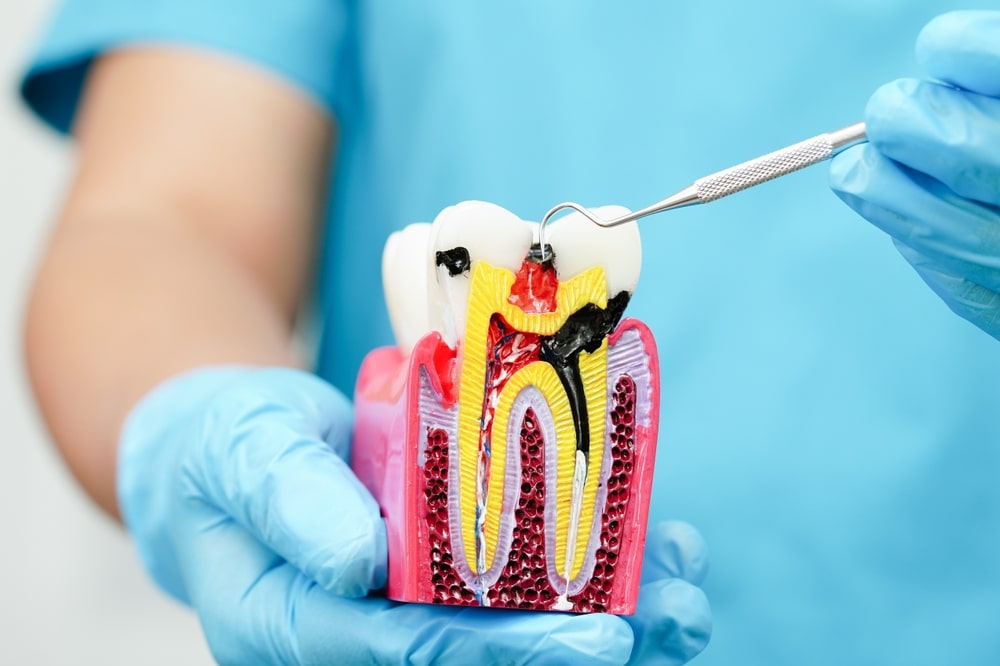Blog Details
-
Total Dental Arts > Blog > Root Canal Dentist > Signs You Might Need A Root Canal
20Oct
Signs You Might Need A Root Canal

As a family dentist here in Centreville, I often talk with patients who are unsure about what’s causing their dental pain. Some have been dealing with sensitivity for weeks, others have swelling in their gums, and many are simply trying to figure out if their tooth can be saved. When symptoms like these appear, it may mean you need a root canal. I’m Dr. Kourosh with Total Dental Arts, and I help patients throughout Fairfax County understand what their symptoms mean and what treatment makes the most sense for them.
A root canal is a common dental procedure that’s designed to save a tooth that has become infected or severely inflamed inside. While the words “root canal” can make some people nervous, I always reassure my patients that the procedure itself is very comfortable. In fact, many feel immediate relief once the infection is removed. My goal is to explain what’s going on and why treatment is necessary so you can make the right decision with confidence.
If you’re wondering whether your symptoms mean you may need a root canal, there are some clear warning signs I encourage my patients to watch for. These symptoms often appear when the soft tissue inside your tooth, called the pulp, becomes damaged or infected. The sooner we can treat the tooth, the better the outcome—and the more likely we are to avoid complications or tooth loss.
Let me walk you through the signs you shouldn’t ignore.
Persistent Tooth Pain
One of the most common signs of a serious tooth problem is pain that doesn’t go away. If you’re experiencing sharp, throbbing, or deep pain—especially when chewing or putting pressure on the tooth. This could mean the pulp is inflamed or infected. Pain that lingers after hot or cold exposure can also be a warning sign. If you’re experiencing this kind of discomfort, don’t wait. Let me take a closer look to determine whether the tooth can be treated with a root canal.
Sensitivity To Heat Or Cold
Occasional sensitivity isn’t always a sign of trouble, but when it becomes sharp, intense, or continues long after the hot or cold item is removed, it could mean there’s nerve damage inside the tooth. This type of temperature sensitivity often means the pulp is no longer healthy and may need to be removed to prevent the infection from spreading.
Swollen Or Tender Gums
If your gums near a tooth are swollen, red, or painful to the touch, that may be a sign of infection. Sometimes a small bump or pimple forms on the gum, which can indicate an abscess. This means the infection has reached the tip of the tooth’s root and is affecting the surrounding tissue. When I see signs like these, I act quickly to eliminate the infection and protect the bone around your tooth.
Darkening Or Discoloration Of The Tooth
When a tooth becomes discolored, usually turning gray or dark brown, it may mean the nerve inside has died. Trauma, decay, or infection can all lead to this kind of internal damage. A root canal may be needed to clean out the dead tissue and restore the tooth’s strength and appearance. I often recommend a crown afterward to protect the tooth and improve the color.
Cracked Or Damaged Tooth
If a tooth has been chipped, cracked, or broken, especially if the damage reaches the inner pulp, it becomes more vulnerable to infection. Even a small crack can allow bacteria to enter and infect the nerve. When this happens, root canal treatment is the best way to save the tooth from being lost or causing further issues.
FAQs About Root Canal Treatment
Why Would I Need A Root Canal Instead Of A Filling?
A filling is used when decay or damage is limited to the outer layers of the tooth. A root canal is necessary when the inner pulp becomes infected or inflamed. If the nerve is involved, a simple filling won’t stop the pain or clear the infection. During a root canal, I remove the damaged pulp, clean the inside of the tooth, and seal it to prevent future problems.
Is A Root Canal Painful?
The idea of a root canal causes worry for some patients, but the procedure itself is not painful. With modern techniques and local anesthesia, I make sure you’re comfortable the entire time. Most patients are surprised at how easy the appointment is. In fact, the root canal actually relieves the pain caused by the infection.
How Do I Know If I Have An Infection In My Tooth?
Signs of infection may include swelling, bad taste in your mouth, pus, or sensitivity when biting. However, sometimes there are no symptoms at all until the infection is severe. That’s why I encourage routine exams. I use digital X-rays and other tools to detect problems early—even before you feel pain.
What Happens After A Root Canal?
After the root canal is complete, I typically place a crown on the tooth to protect it. The tooth itself no longer has a nerve, so while it won’t feel temperature sensitivity, it still functions like a normal tooth. With proper care, your restored tooth can last many years.
Can I Avoid Needing A Root Canal?
You can reduce your risk by brushing, flossing, and visiting my office regularly for cleanings and exams. Avoid chewing hard objects and address cavities or cracked teeth quickly. When problems are caught early, we can treat them without needing a root canal.
Protect Your Smile With Help From Dr. Kourosh At Total Dental Arts
If you’re experiencing tooth pain, swelling, or other symptoms that don’t feel right, don’t ignore them. At Total Dental Arts in Centreville, I take a gentle and personalized approach to diagnosing and treating root canal problems. You deserve to feel comfortable and confident with your dental care.
If you’re worried you may need a root canal or want to get relief from your symptoms, contact our Centreville root canal dentist Dr. Kourosh at Total Dental Arts by calling (703) 890-3200 to schedule your consultation. I welcome patients from Centreville and all across Fairfax County, Virginia, and I look forward to helping you protect your teeth and your health.
